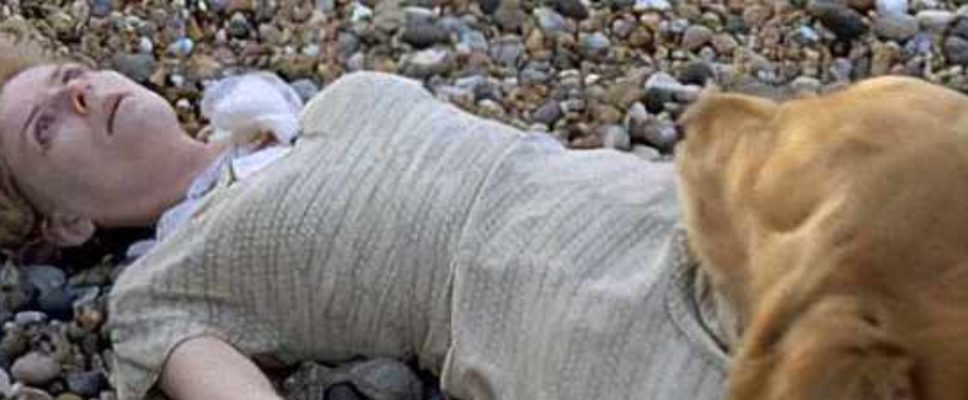Teresa Reviews “The ABC Murders” (1992)
Summary: Teresa reviews “The ABC Murders” (1992) and finds it a better, if slightly flawed version than the Tony Randall 1965 “comedy.”
Fidelity to text: 4 blunt objects
![]()
It’s very close to the novel; minor characters and subplots are replaced by a stuffed South American alligator (aka Cedric the caiman).
Quality of movie on its own: 4 blunt objects
![]()
But only because what works in prose doesn’t work on film. It’s hard to fudge split-second timing and crossing town in minutes in a movie.
Read more of Teresa’s Agatha Christie movie reviews at Peschel Press.
Also, follow Teresa’s discussion of these movies on her podcast.
The ABC Murders is regarded as one of Agatha’s finest novels. Although she didn’t use the phrase “serial killer” in 1936, that’s what the murderer looks to be. There’s multiple, unconnected murders, and a strange, ambivalent character drifts through the novel under very suspicious circumstances. When you’re sure that Agatha Christie — groundbreaking as always — has written the proto-serial killer novel, she yanks the rug out from under you. You realize she fed you the biggest red herring ever.
And you swallowed it whole.
I’m amazed that people dismiss her novels as formulaic. They’re not. She tried new things, yet she was very cognizant of the reasons most murders are committed: money, status and/or security, and passion. Insanity is a reason too, but it’s not why police investigate the grieving spouse first. Crocodile tears are easily confused with real ones if the grieving spouse is a good-enough actor.
Nor is insanity the reason why police next investigate who benefited financially from someone’s death. Money is a huge motivator. Why wait to inherit when you can shove your elderly, annoying, and unsteady older brother down a flight of stairs and cash out sooner? Particularly if your older brother plans to marry his smoking-hot secretary the minute his ailing wife dies and gasp(!) sire an heir? If she produces an heir, you’ve future has changed for the worse. The estate, the money, the title? All gone the minute that mewling, puking son is born. Each subsequent son moves you further from the prize.
Look at Princess Margaret. She moved from second in line to the throne of the greatest Empire the world has known to a longshot. Was she ever tempted to push Liz down a flight of stairs? Or Prince Charles, who’s become the world’s oldest second banana?
You, dear reader, can see why a younger brother might not take any chances. The problem, as Agatha knew, is that the primary beneficiary is also the primary suspect. She knows it, the police know it, we know it, and so does Hercule Poirot. So how can a murder be concealed?
By hiding it within a crowd of murders.
Just like a man can disappear into a crowd at a racetrack, a group of murders can conceal the one that matters by hiding important facts behind flashy distractions. Say, a murder of a woman whose initials are A.A. and she lives in Andover. Followed by a woman whose initials are B.B. and she lives in Bexhill. A man whose initials are C.C. who lives in Churston is an obvious next victim of a madman. Why, there’s nothing special about his death at all. He’s the next in the string, soon to be followed by D.D. in Doncaster and E.E in Exeter.
Everyone, police and Poirot included, swallow the red herring.

Poirot is nonplussed until he realizes that Cedric is a gift from the heart and then he has to find room in his flat to accept the smelly reptile. As comic relief, Cedric works infinitely better than all the supposedly comic scenes combined in the Tony Randall/Robert Morley version of The A.B.C. Murders. Cedric pops up occasionally during the investigation and figures prominently in the dénouement.
Cedric serves as a metaphor that you can’t trust what people say: always watch for crocodile tears. The crocodile weeps while eating his prey. He’s sad, or pretends to be sad, while getting exactly what he wants.
Our murderer, as you would expect from Agatha, the most likely suspect. He’s Franklin Clarke, Lord Carmichael Clarke’s younger brother, and played by Donald Douglas.

Contrast him with Donald Sumpter, who was perfect playing Alexander Bonaparte Cust.

The other reason for this not being a five blunt object film is the unbelievable scenes at the St. Leger Stakes horserace in Doncaster. There’s a lot of period stock footage carefully woven into the film. That worked fine.
 What didn’t work was believing that Franklin Clarke could work his way out of that packed, jostling mob of humanity, run into the city, track down Cust at his hotel, follow him into a movie theater, stab a random victim (who, unbelievably, did not scream when stabbed in the back!), slide his knife and bloody handkerchiefs into Cust’s overcoat pocket, slip out of the theater unnoticed and race back through the St. Leger Stakes mob and return to his seat in time for the rest of the gang to join him.
What didn’t work was believing that Franklin Clarke could work his way out of that packed, jostling mob of humanity, run into the city, track down Cust at his hotel, follow him into a movie theater, stab a random victim (who, unbelievably, did not scream when stabbed in the back!), slide his knife and bloody handkerchiefs into Cust’s overcoat pocket, slip out of the theater unnoticed and race back through the St. Leger Stakes mob and return to his seat in time for the rest of the gang to join him.

Everything else about this movie worked beautifully. The difference between this version and the Tony Randall atrocity is like night and day. Watch this version. It’s terrific, with added period horse racing and stuffed caimans instead of Robert Morley stuffed into a towel.

Read more of Teresa’s Agatha Christie movie reviews at Peschel Press.

